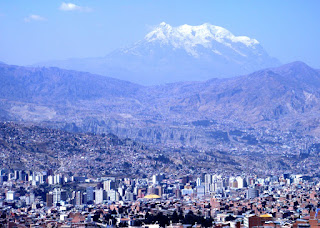









It would be a big mistake to imagine that the Andes Altiplano (High Plains)was comparable to a table top onto which one could climb. In reality the plains are protected by big mountain passes over which one has to grind in the lean air. From an altitude of 2 500 metres at Cochabamba I climbed over 4 distinct high passes, descending again after each pass before climbing even higher over the next. The highest point on the road was at 4 500 metres before descending to the Altiplano at around 4 000 metres. There is no accommodation in these mountains, and I camped a couple of times at high altitude. On the second night after leaving Cochabamba I was camping on a ledge at 4 000 metres (I was hidden from the road, but some of the local tribal people spotted me from a path high above - no problem, as they waved and greeted me politely in Spanish). Those mountains are very desolate, and one of the few animals which can survive there are llama´s - the farmers herd the llama´s on the steep slopes with the use of ¨sheep-dogs¨. As I often do in the absence of any fixed object, I propped the bike up out of the dust and locked it to my tent for the night. At that altitude it became quite cold in the night, so I dressed appropriately and crawled down into the sleeping bag. During the night Old Saartjie blew over onto the tent, and with bike theft in mind I tried to jump into action with pepper spray and fish knife at the ready. However, with all that protection against the cold I got myself into such a tangle that I was fortunate not to cause myself any grevious bodily harm! (I wonder about that incident, as the bike was leaning away from the tent and there was only a light breeze). Later at the miserable dusty Altiplano junction town of Caracolle I stayed in an appropriately miserable room - the door could not even be closed properly from outside. During the night I had to trot to the equally miserable filthy downstairs toilet on regular occasions due to a stomach problem, and one of my fellow "inmates" stole my old, dirty, broken 2Oceans Marathon T-shirt from where it was hanging close to the door. Things get stolen for re-sale and not personal use, and the Nike sponsors logo on the sleeve must have been a deciding factor. However, upon closer examination the thief was unhappy with his catch, because I later recovered the stolen shirt from the hook behind the toilet door. Due to the thin air at altitude I often went into Oxygen Debt, and had to stop to hyperventilate until my head cleared and some strength returned to my legs. I reached Calamarca village early in the day on my way to La Paz, but I was so exhausted that I decided to see if they had any accommodation. Upon enquiry at the roadside I was informed that there was indeed a hotel up the hill at the plaza, opposite the historic cathedral (they even told me how much a room would cost). Well, when I got up there I found no such accommodation, and a ¨Man Of the Cloth¨(the Padre of the Cathedral complex) allowed me to camp out in one of the empty school-rooms. I was pleased about that as there was a fairly strong icy wind blowing on the plains - there was even a toilet in the back yard, with lots of guinea pigs charging about (I imagine the Padre knabs a fat one every week for his Sunday lunch). And then it was the final stretch to La Paz, at 3 600 metres the highest capital city around. At first I didn´t think much of the place, as I had to battle it out with taxi´s and busses through the dusty and dirty outlying El Alto. But when I did spot the city, it was an absolutely amazing sight. There was no prior warning, suddenly the earth fell away in front of me and there lay this spectacular city with the centre on the deep valley floor and buildings hugging the impossibly steep valley walls- with Mt Illimani in the background. Later, looking for cheap accommodation up and down the steep cobbled streets of the backpacker area, I was directed to a touring cyclists haven (Casa De Cyclistas), where at one point there were eight bicycles clogging the small place. It was also great to swap stories with the other cyclists, and just to have a normal conversation again for the first time since I left Leana in Rio De Janeiro 2 months ago. La Paz is a good place to acclimatise as it is situated at a slightly lower altitude than the surrounding area, and I´ve been here for a few days already. So, tomorrow I´ll move on again. Daily distances cycled since Cochabamba have been:- Parotan Camp 69 km; Pongo Camp 40 km; Caracolle 90 km; Patacamaya 91 km; Calamarca 46 km; and La Paz 65 km. Total in South America is 12 397 km, and total cycled since the start of this jouney is 78 884 km.

















